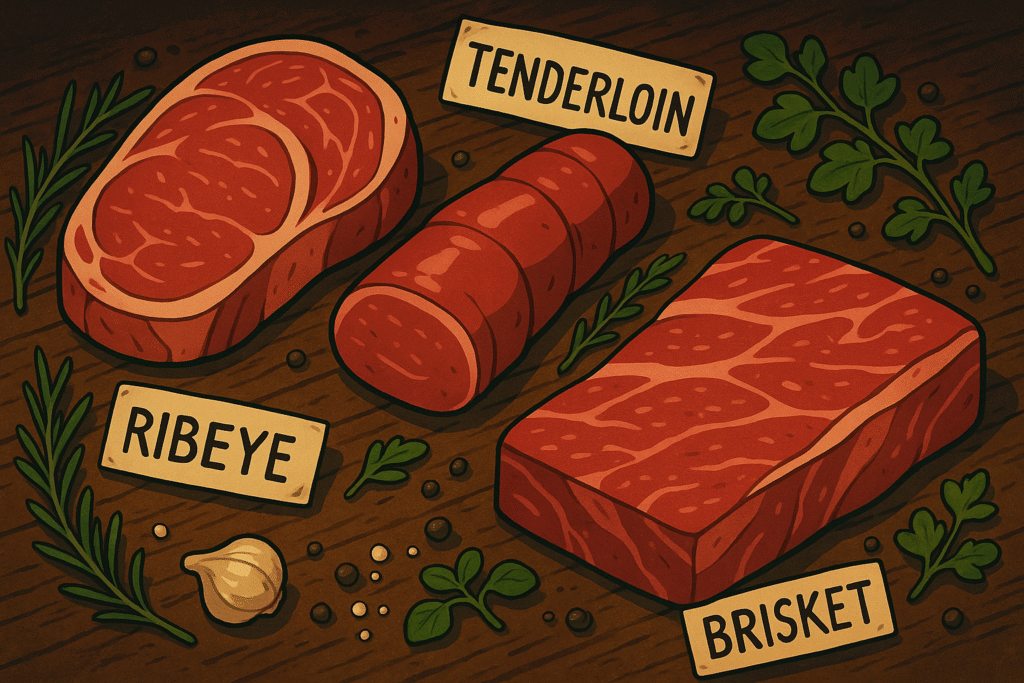Beef (Bos taurus)

About Beef
Beef is more than just meat — it’s an ingredient that carries immense cultural weight, diverse flavor profiles, and endless culinary applications. From stews in Ethiopia to wagyu steaks in Japan, beef has carved out a central spot in global gastronomy.
Its flavor ranges from grassy and mild to deeply umami, depending on the breed, feed, and cut. Whether grilled, braised, cured, or raw, beef adapts across cultures — a canvas for spices, smoke, and age-old tradition.
The History of Beef
Domesticated from wild aurochs thousands of years ago in the Fertile Crescent, cattle were originally prized more for labor, milk, and spiritual significance than meat. Beef consumption became widespread only later, especially in societies with the resources to raise cattle specifically for slaughter.
In Europe, beef was long associated with aristocracy, while pork fed the masses. In India, cattle hold sacred status, shaping culinary norms. Meanwhile, South America — especially Argentina and Brazil — made beef a national identity, where gauchos and open-fire grilling are cultural emblems.
The Industrial Revolution and refrigeration made beef a global export, transforming it into a supermarket staple — but its roots remain deeply regional and ritualistic.
The Science of Beef
Beef’s complex flavor comes from amino acids, fats, and sugars that react during cooking through the Maillard reaction, creating browned, savory notes.
Marbling (intramuscular fat) is key — more marbling often means more tenderness and juiciness, especially in breeds like Wagyu. Aging also matters: dry-aged beef concentrates flavor through moisture loss and enzymatic breakdown, giving a nutty, umami intensity.
Beef’s nutritional profile includes high-quality protein, B12, iron, and zinc — though the specifics vary by cut and fat content.
The Geography of Beef
Beef is raised around the globe, but terroir still matters. Grass-fed cattle in Argentina or Ireland develop leaner meat with herbal notes, while corn-fed American beef tends to be fattier and sweeter.
Japan’s Wagyu is reared under strict guidelines for texture and flavor, while Brazil dominates global exports with its vast pasture systems. Highland beef in Scotland, zebu in India, or yak in Tibet — each region has its own cattle lineage and flavor legacy.
Varieties of Beef
Wagyu
A Japanese breed famous for intense marbling and a melt-in-your-mouth texture. Often served seared or raw in ultra-thin slices to highlight its richness.
Angus
Known for balanced marbling and beefy flavor, Angus is widely raised in the US, UK, and Australia — ideal for steaks and burgers.
Highland
A heritage Scottish breed with lean, richly flavored meat, often from slower-grown cattle grazed on rugged terrain.
Charolais
A French breed prized for tender, mild-tasting meat and often used in fine dining and traditional French dishes.
Zebu (Brahman)
Humped cattle common in tropical zones. Leaner and often tougher, Zebu beef is used in curries, stews, and air-dried preparations.
FAQs All your questions about Beef: answered
What’s the most tender cut of beef?
The tenderloin (also known as filet) is the most tender, but ribeye offers more flavor due to its fat content.
Is grass-fed beef better than grain-fed?
Grass-fed tends to be leaner with a gamier flavor. Grain-fed is usually fattier and sweeter. It’s all about preference.
Can beef be eaten raw?
Yes — in dishes like tartare or carpaccio — but only with high-quality cuts and safe handling.
What’s the difference between dry-aged and wet-aged beef?
Dry-aged beef is hung in open air for weeks to concentrate flavor. Wet-aged is vacuum-sealed and more common in supermarkets.